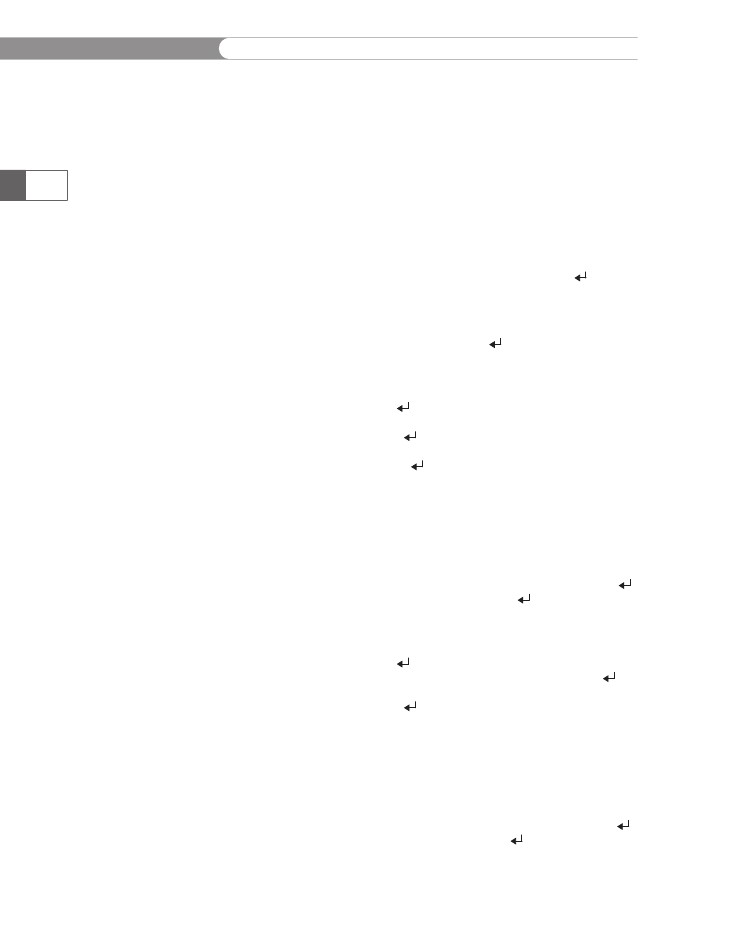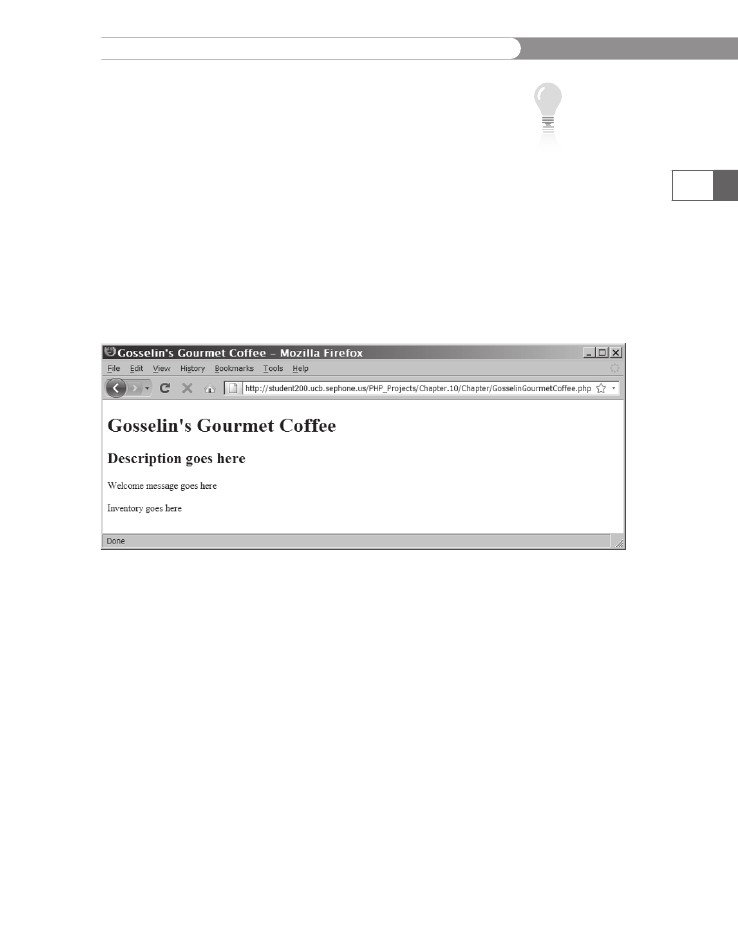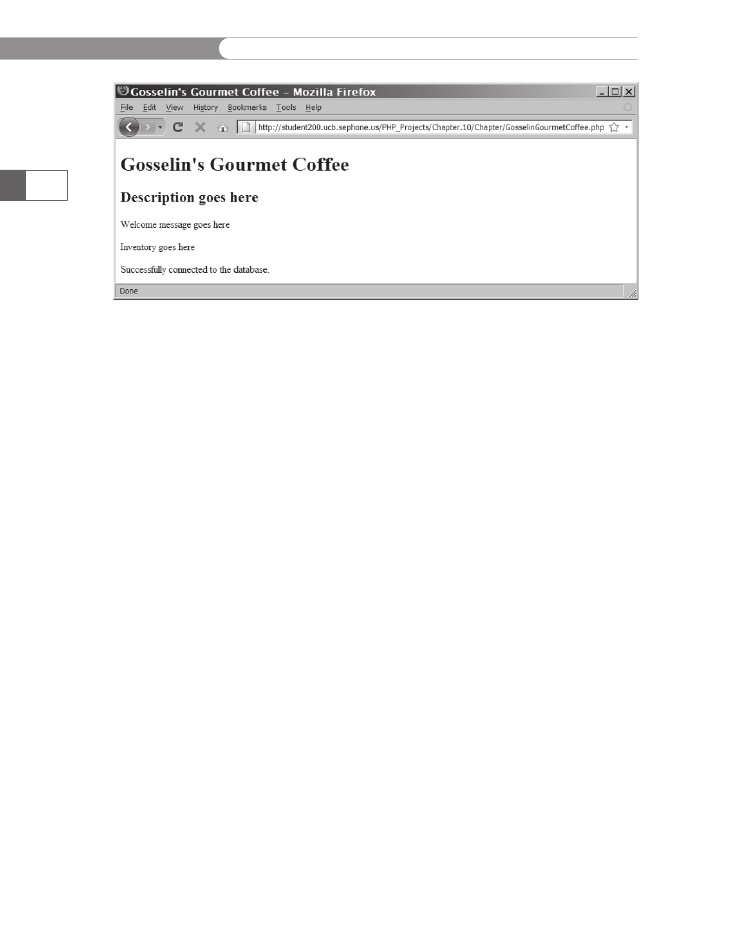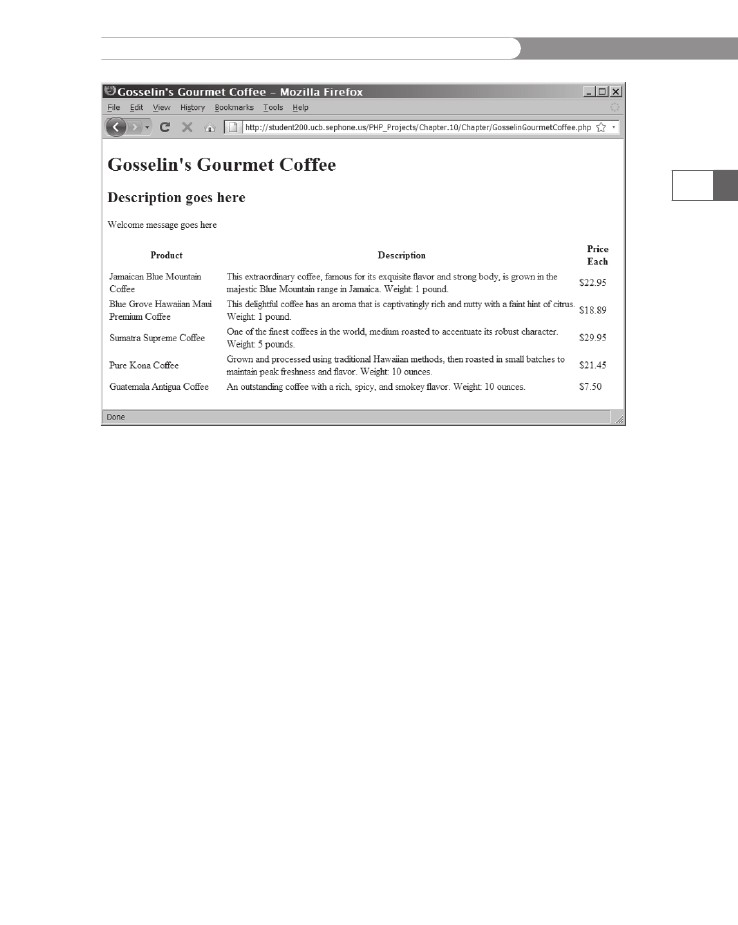
- •Initializing with Constructor Functions . . . . .
- •Into a Web page as a separate section. Although JavaScript code can
- •Is that standard php script delimiters are guaranteed to be available
- •In the block. Any text or lines between the opening /* characters and
- •2.7541 Are not integers; they are floating-point numbers. A floating-
- •Value 300
- •Is a value of 2.5, because 6 goes into 15 exactly 2.5 times. But if you
- •IsEven.Php.
- •Ing example,
- •Ing curly brace is on its own line following the function statements.
- •In php 3 and earlier, it was necessary to put a function definition
- •Is called an iteration. When the conditional expression evaluates
- •Including Files
- •13. Close your Web browser window.
- •Including Files
- •In php, you can also use two operators to combine strings. The first
- •Xhtml source code gen-
- •Input. Php provides several functions for manipulating the case of a
- •Is uppercase. If you need the reverse of ucfirst(), the lcfirst()
- •In some situations, you will need to find and extract characters and
- •Information Interchange, or ascii, which are numeric represen-
- •In comparison, the following preg_match() function returns a value
- •In the pattern is optional. The following code demonstrates how to
- •Values; any strings you validate against a regular expression must
- •Value of 1 because the top-level domain contains a valid value of .Com.
- •Is submitted using the “post” method, the form data is embedded in
- •Validating String Data
- •Xhtml tags or character entities. The message field is a text string
- •Value of the header element. For example:
- •Xhtml code within a php script section.
- •Is typically the person who created the resource. Otherwise, the net-
- •If even a single character of the Web page is sent prior to sending
- •Variables to the file_put_contents() function.
- •Xhtml hyperlink. To download a file from outside the xhtml
- •If...Else statement to display the appropriate version of the mes-
- •Iterating Through an Array
- •Iterating Through an Array
- •In Chapter 2, you learned how to use a foreach statement to iterate
- •Iterating Through an Array
- •Iterating Through an Array
- •In comparison, the following code declares and initializes
- •If ((!file_exists("MessageBoard/messages.Txt"))
- •Values from the array to create a thumbnail gallery of images in which
- •Introduction to Databases
- •Including php, allow you to create Web pages that can read and write
- •Introduction to Databases
- •Information that can be organized into ordered sets of data, and
- •Information. Each recipe in a recipe database, for instance, is a single
- •Introduction to Databases
- •Index, which identifies records in a database to make retrievals and
- •In a single table. However, you might want to break the information
- •Into multiple tables to better organize it into logical sets. Another
- •Information in one of the tables confidential and accessible only by
- •Is the employee information table from Figure 7-1. The related table
- •Is a payroll table that contains confidential salary and compensation
- •Information. Notice that each table contains an identical number of
- •Introduction to Databases
- •Introduction to Databases
- •In a junction
- •Introduction to Databases
- •In a relational format is called a relational database management
- •Is a standard data manipulation language among many dbmSs.
- •Into the query area at the top of the screen or by dragging tables and
- •It is important to understand that even though many dbmSs sup-
- •Introduction to Databases
- •If you ever
- •Is. In comparison, the bigint data type stores integer values between
- •5 Rows in set (0.00 sec)
- •Int);[enter ]
- •Important, these two tabs can cause you to lose all of the data in the
- •Internet Explorer to export the table, click the Save button in the File
- •Ifies the table being changed and the change to make.
- •It easier for you to write php code that can be used with a variety of
- •Information about queries that match one of the following formats:
- •Various types of actions, depending on the type of query.
- •Include fields for the date and time of the flight, flight number, and
- •In the ChineseZodiac folder and upload the file to the server. Open
- •Including white space,
- •Information on a Web server. When you start a new session, the
- •Introduction to Object-Oriented Programming
- •Introduction to Object-Oriented
- •Variables associated with an object are called properties or attributes.
- •In the Loan object example, a function that calculates the number of
- •Introduction to Object-Oriented Programming
- •Introduction to Object-Oriented Programming
- •Include instances of objects inherit the object’s functionality.
- •In this chapter, you will create the Web site for an online order form
- •In an online store application. The application includes information
- •Ity of building a working online store. Online store classes are very
- •Information and products. The OnlineStore class requires that store
- •Information is stored in a table containing six fields: storeId, name,
- •Information. Instead, the class simply uses session iDs to keep track
- •Variable and function as necessary, without bothering with all this
- •In a class
- •Is developed. Imagine what would happen if Microsoft distributed
- •Ing class is invalid because it does not include an access specifier:
- •If they will not be supported by future xhtml versions or are not
- •Xhtml standards. To review the guide of current w3c css specifi-
- •Information to remind yourself or others of what the code is doing. A
- •Xhtml document to the external style sheet. This link informa-
- •If you select Apache from the WampServer menu and select Service
- •Ing code uses the number_format() function to add comma separa-
- •In data that a user submits to a php script.
- •Value of “On” and the display_startup_errors directive is assigned
- •Instead. By looking at the source code, you could see that the value of
- •Ing engine can even help locate logic errors.
- •In Chapter 8, along with the equivalent mssql_* functions, where
- •Inline styles, 632
- •Xhtml, 620–635 (continued)
class.
A particular instance of an object inherits
its
methods and
properties
from a class—that is, it takes on the characteristics of
the
class on which it is based. The BankAccount
object,
for instance,
would
inherit all of the methods and properties of the BankAccount
class.
As another example, when you create a word-processing docu-
ment,
which is a type of object, it usually inherits the properties of a
template
on which it is based. The template is a type of class, and the
document
inherits characteristics of the template, such as font size,
line
spacing, and boilerplate text. In the same manner, programs that
about
each store and a custom inventory for each store. The primary
store
you will use is Gosselin’s Gourmet Coffee, which sells various
blends
of coffee beans. The purpose of the Web site is to demonstrate
code
reuse with classes. As you progress through this chapter, you
will
develop a class named OnlineStore
that
handles the functional-
popular
with PHP development because of the many Web sites that
allow
visitors to purchase items. Rather than recreating the same
functionality
for each online store, you can much more easily develop
the
Web site by reusing an existing online store class. As you create
the
OnlineStore
class,
notice that its functionality has nothing to do
with
Gosselin’s Gourmet Coffee or coffee beans. Instead, the code is
generic
enough that it can be used with any Web site that sells prod-
ucts,
provided the pages in the site and the associated database con-
form
to the requirements of the class.
First,
you create the database and tables that store the online store
description,
welcome,
css_file,
and email_address.
The storeID
field
is the primary key and consists of a unique text field. For exam-
ple,
the primary key for Gosselin’s Gourmet Coffee is COFFEE.
The
OnlineStore
class
also requires that product information is stored in
a
table containing five fields: productID,
storeID,
name,
description,
and
price.
The productID
field
is the primary key and consists of a
unique
text field. For example, the primary key for the first product
for
Gosselin’s Gourmet Coffee is COFFEE001.
The storeID
stores
the
unique
ID number for the store that sells the product. To keep things
simple,
the OnlineStore
class
does not store customer or payment
of
each user’s shopping cart.
Next,
you create a database named online_stores
along
with two
tables:
store_info,
to contain configuration information for each
Class
namesIntroduction to Object-Oriented Programming
Include instances of objects inherit the object’s functionality.
In this chapter, you will create the Web site for an online order form
In an online store application. The application includes information
Ity of building a working online store. Online store classes are very
Information and products. The OnlineStore class requires that store
Information is stored in a table containing six fields: storeId, name,
Information. Instead, the class simply uses session iDs to keep track
in traditional
object-ori-
ented pro-
gramming
usually begin with an
uppercase letter. This
convention is also
followed in PHP.
561

CHAPTER
10
Developing
Object-Oriented PHP
store,
and inventory,
to contain product information. Your Chapter
directory
for Chapter 10 contains two text files, store_info.txt and
inventory.txt,
which contain store and product information to load
into
each database table.
To
create the Online Stores database:
562
1.
Log
in to MySQL Monitor with the MySQL user name and
password
you created in Chapter 7.
Enter
the following command to create a database named
online_stores:
mysql>
CREATE DATABASE online_stores;[ENTER
]
2.
3.
After
you see the “Query OK” message, enter the following
command
to select the online_stores
database:
mysql>
USE online_stores;[ENTER
]
4.
Enter
the following command to create the store_info
table:
mysql>
CREATE TABLE store_info (storeID VARCHAR(10)
PRIMARY
KEY,[ENTER ]
->
name VARCHAR(50), description VARCHAR(200),
welcome TEXT,[ENTER ]
-> css_file VARCHAR(250), email_address
VARCHAR(100));[ENTER ]
5.
After you see the “Query OK” message, enter a LOAD DATA
statement that inserts records into the store_info table from
the store_info.txt file in your Chapter directory for Chapter
10. Replace path with the path to your Chapter directory for
Chapter 10.
mysql> LOAD DATA INFILE 'path/store_info.txt'[ENTER
-> INTO TABLE store_info;[ENTER ]
]
6.
Enter the following command to create the inventory table:
mysql> CREATE TABLE inventory (storeID
varchar(10),[ENTER ]
-> productID VARCHAR(10) PRIMARY KEY,[ENTER ]
-> name VARCHAR(100), description VARCHAR(200),
price FLOAT);[ENTER ]
7.
After you see the “Query OK” message, enter a LOAD DATA
statement that inserts records into the inventory table from
the inventory.txt file in your Chapter directory for Chapter
10. Replace path with the path to your Chapter directory for
Chapter 10.
mysql> LOAD DATA INFILE 'path/inventory.txt'[ENTER
-> INTO TABLE inventory;[ENTER ]
]

Using
Objects in PHP Scripts
8.
Type
exit
or
quit
and
press Enter
to
log out of MySQL
Monitor.
Short
Quiz
1.
2.
3.
4.
Discuss
the benefits of object-oriented programming.
Explain
how objects can be shared by multiple programming
languages
such as PHP, C++, and Visual Basic.
Identify
three benefits of encapsulating code.
Define
the term “instance of a class.”
563
Using
Objects in PHP Scripts
Up
to this point, all of the PHP scripts you have written contained
procedural
statements that did not rely on objects. Many of the
skills
you have learned so far will help you construct object-oriented
programs.
However, object-oriented techniques will help you build
more
extensible code that is easier to reuse, modify, and enhance. In
this
section, you will learn how to work with database connections
as
objects to help you understand how to use objects in your scripts.
Then,
you will learn how to define your own custom classes.
Before
you begin working with database connections as objects, you
first
need to understand a few basics of how to work with objects in
PHP.
You declare an object in PHP by using the new
operator
with a
class
constructor. A class
constructor is
a special function with the
same
name as its class; it is called automatically when an object from
the
class is instantiated. For example, the class constructor for the
BankAccount
class
is BankAccount().
The syntax for instantiating an
object
is as follows:
$ObjectName
= new ClassName();
The
identifiers you use for an object name must follow the same rules
as
identifiers for variables: They must begin with a dollar sign, can
include
numbers or an underscore (but not as the first character after
the
dollar sign), cannot include spaces, and are case sensitive. The
fol-
lowing
statement instantiates an object named $Checking
from
the
BankAccount
class:
$Checking
= new BankAccount();
CHAPTER
10
Developing
Object-Oriented PHP
Class
constructors are primarily used to initialize properties when an
object
is first instantiated. For this reason, you can pass arguments
to
many constructor functions. For example, the BankAccount
class
might
require you to pass the account number as a parameter, as
follows:
564
$Checking
= new BankAccount(01234587);
After
you instantiate an object, you use the combination of a hyphen
and
a greater-than symbol (->)
to access the methods and properties
contained
in the object. Together, these two characters are referred to
as
member
selection notation.
Using member selection notation is
similar
to using an operator in that you append one or more charac-
ters
(in this case, ->)
to an object, followed by the name of a method
or
property. With methods, you must also include a set of parenthe-
ses
at the end of the method name, just as you would with functions.
Like
functions, methods can also accept arguments.
The
following statements demonstrate how to call two methods,
getBalance()
and
getCheckAmount(),
from the $Checking
object.
The
getBalance()
method
does not require any arguments, whereas
the
getCheckAmount()
method
requires an argument containing the
check
number.
$Checking->getBalance();
$CheckNumber
= 1022;
$Checking->getCheckAmount($CheckNumber);
The
printf()
function,
which allows
you to format
variables in an output
string, is described in
Appendix C. In this exam-
ple, the format specifier
%.2f causes the balance
to be displayed as a float-
ing-point number (f) with
two digits (specified by
the 2) after the decimal
point.
To access property values in an object, you do not include parenthe-
ses at the end of the property name, as you do with functions and
methods, nor do you include a dollar sign before the property name.
For example, the following statements update and display the value in
a property named $Balance in the $Checking object:
$CheckAmount = 124.75;
$Checking->Balance = $Checking->Balance + $CheckAmount;
printf("<p>Your updated checking account balance is
$%.2f.</p>", $Checking->Balance);
Next, you start creating the GosselinGourmetCoffee.php script,
which displays the coffee products available for purchase. The first
version of the script simply queries the database and displays a table
with the product information. Later in this chapter, you will modify
the script so it uses the OnlineStore class.
To create the GosselinGourmetCoffee.php script:
1.
Create a new document in your text editor and type the
<!DOCTYPE> declaration, <html> element, header informa-
tion, and <body> element. Use the strict DTD and “Gosselin’s
Gourmet Coffee” as the content of the <title> element.

Using
Objects in PHP Scripts
2.
Add
the following text and elements to the document body:
<h1>Gosselin's
Gourmet Coffee</h1>
<h2>Description
goes here</h2>
<p>Welcome
message goes here</p>
<p>Inventory
goes here</p>
3.
Save
the document as GosselinGourmetCoffee.php in the
Chapter
directory for Chapter 10 and upload the document to
the
Web server.
Open
the GosselinGourmetCoffee.php file in
your
Web browser by entering the following URL:
http://<yourserver>/PHP_Projects/Chapter.10/Chapter/
GosselinGourmetCoffee.php.
Your Web browser should look
like
Figure 10-3.
4.
At
this point,
the file has no
PHP code
sections.
Normally, a
file like this would be
saved with an .html exten-
sion. You save it with a
.php extension because
you will add PHP code
later in the chapter.
565
Figure 10-3
5.
The Gosselin’s Gourmet Coffee Web page
Close your Web browser window.
Working with Database Connections as Objects
PHP allows you to connect to and manipulate MySQL and other
types of databases using either procedural statements or object-ori-
ented techniques. Although you should not notice any performance
issues when using procedural statements or object-oriented tech-
niques to access MySQL databases, you can expect object-oriented
techniques to become the preferred method as PHP continues to
evolve. For this reason, you should get used to the object-oriented
method of accessing MySQL databases. As mentioned in Chapter
8, the mysqli package is the object-oriented equivalent of the mysql
package. The mysqli package will be used throughout this chapter.
You access MySQL database connections as objects by instantiat-
ing an object from the mysqli class. The mysqli class contains

CHAPTER
10
Developing
Object-Oriented PHP
566
methods
and properties that have the same functionality as the
procedural
MySQL database connection statements you have used
so
far. For example, the equivalent of the mysql_query()
function
is
a method named query()
in
the mysqli
class,
and the equiva-
lent
of the mysql_affected_rows()
function
is a property named
affected_rows
in
the mysqli
class.
Next, you will learn how to
instantiate
and close a MySQL database connection object.
Instantiating
and Closing a MySQL Database Object
In
Chapter 8, you learned how to use the mysql_connect()
function
to
open a connection to a MySQL database server. When connecting
to
the MySQL database server using object-oriented techniques, you
instantiate
an object from the mysqli
class.
You pass to the mysqli
class
the same host,
user,
password,
and database
arguments
that
you
pass to the mysql_connect()
and
mysql_select_db()
functions.
For
example, the following statements use the mysql_connect()
and
mysql_select_db()
functions
to connect to a MySQL database server:
$DBConnect
= mysql_connect("php_db", "dongosselin",
"rosebud");
mysql_select_db("real_estate", $DBConnect);
You can
use the
select_db()
method of the
mysqli
object to select a
different database.
In comparison, you use the following statement to connect to the
MySQL database server using a mysqli object:
$DBConnect = new mysqli("php_db", "dongosselin",
"rosebud", "real_estate");
The preceding statement uses the mysqli() constructor function to
instantiate a mysqli class object named $DBConnect.
Instead of using the mysql_close() function to explicitly close the
database connection when you finish working with it, you call the
close() method of the mysqli class. For example, the following state-
ment closes the database connection represented by the $DBConnect
object (remember that $DBConnect is an object of the mysqli class):
$DBConnect->close();
To add statements to the GosselinGourmetCoffee.php script that
instantiate and close a database connection to the MySQL database
server using a mysqli object:
1.
Create a new document in your text editor with the following
script section:
<?php
?>
2.
Add the following statements to the script section to connect
to the database server using a mysqli object. The code uses
Using
Objects in PHP Scripts
an
if
statement
to store an error message in the $ErrorMsgs
array
if there was a connection error. Be sure to replace host,
user,
and password
with
your MySQL server name, user
name,
and password.
$ErrorMsgs
= array();
$DBConnect
= new mysqli("host", "user", "password",
"online_store");
if (!$DBConnect)
$ErrorMsgs[] = "The database server is not
available.";
567
3.
Save the document as inc_OnlineStoreDB.php in the Chap-
ter directory for Chapter 10.
Return to the GosselinGourmetCoffee.php script in your
text editor.
Add the following script section to the start of the document,
before the <!DOCTYPE> tag:
<?php
require_once("inc_OnlineStoreDB.php");
?>
4.
5.
6.
Add the following script section to the body of the document,
immediately before the closing </body> tag:
<?php
if (count($ErrorMsgs)) {
foreach ($ErrorMsgs as $Msg)
echo "<p>" . $Msg . "</p>\n";
}
else
echo "<p>Successfully connected to the
database.<p>\n";
?>
7.
Add the following script section to the end of the document
to close the database connection:
<?php
$DBConnect->close();
?>
8.
Save the GosselinGourmetCoffee.php file and then upload
inc_OnlineStoreDB.php and GosselinGourmetCoffee.php to
the Web server.
Open the GosselinGourmetCoffee.php script in your Web
browser by entering the following URL: http://<yourserver>/
PHP_Projects/Chapter.10/Chapter/GosselinGourmetCoffee.
php. You should see the message about successfully connect-
ing to the database server (see Figure 10-4).
9.

CHAPTER
10
Developing
Object-Oriented PHP
568
Figure
10-4
Gosselin’s
Gourmet Coffee Web page after connecting to the database server
10.
Close
your Web browser window.
Handling
MySQL Errors
When
you use procedural syntax to connect to the MySQL database
server,
the mysql_connect()
function
returns a value of FALSE
if
the
database connection attempt fails. However, when you use the
mysqli()
constructor
function to instantiate a new database object
from
the mysqli
class,
an object is instantiated even if the database
connection
fails. That means the if
(!$DBConnect) statement
in
inc_OnlineStoreDB.php
would always evaluate to FALSE.
To deter-
mine
if the database connection attempt failed when working with
the
mysqli
object,
you need to use the connect_errno
data
member
of
the mysqli
object
to retrieve the error code from the last connec-
tion
attempt. A value of 0 indicates no error, or a successful connec-
tion.
A nonzero value indicates that the connection attempt failed, as
in
the following example:
$DBConnect
= @new mysqli("php_db", "dgosselin",
"rosebud");
if
($DBConnect->connect_errno) {
echo
"<p>Unable to connect to the database server.</p>"
. "<p>Error code " . $DBConnect->connect_errno
. ": " . $DBConnect->connect_error . "</p>\n";
}
else {
// code that executes if the database connection attempt
// succeeded
}
Notice in the preceding example that the first statement, which
instantiates the database connection object, uses the error control
operator, @, to suppress error messages. Recall that you can place the
Using
Objects in PHP Scripts
error
control operator before any expression to suppress error mes-
sages.
The error control operator in the preceding example is placed
before
the new
operator
because it begins the expression that instanti-
ates
the database connection object.
It
is important to note that the mysqli
class
members connect_errno,
connect_error,
errno,
and error
are
data members, or variables, of
the
database connection object. In the procedural mysql
package,
the
corresponding
mysql_errno()
and
mysql_error()
are
functions.
Most
of the methods of the mysqli
class
return values of TRUE
or
FALSE,
depending on whether the operation was successful.
Therefore,
for any methods of the mysqli
class
that fail (as indi-
cated
by a return value of FALSE),
you can use the same if...else
structure
as you did in Chapter 8. For example, the following state-
ment
checks the return value of the select_db()
method
to display
an
error message if a value of FALSE
was
returned. Notice that the
object-oriented
$DBConnect->errno
and
$DBConnect->error
data
members
are used in place of the procedural mysql_errno()
and
mysql_error()
functions,
and that the statement which calls the
select_db()
method
also uses the error control operator to suppress
error
messages.
$DBName
= "vehicle_fleet";
$Result
= @$DBConnect->select_db($DBName);
if
($Result === FALSE)
echo
"<p>Unable to select the database. " .
"Error code " . $DBConnect->errno .
": " . $DBConnect->error . "</p>\n";
else {
// Code to execute if database selected successfully.
}
569
To add MySQL error-checking functionality to the
GosselinGourmetCoffee.php script:
1.
Return to the inc_OnlineStoreDB.php script in your text
editor.
Add the error control operator (@) before the new keyword, as
follows:
$DBConnect = @new mysqli("host", "user", "password",
"online_stores");
2.
3.
Replace the if statement with the following if statement that
checks the value of the $DBConnect object’s connect_errno
data member to see if it is nonzero, indicating a connection
error:
CHAPTER
10
Developing
Object-Oriented PHP
if
($DBConnect->connect_errno)
$ErrorMsgs[]
= "Unable to connect to the
database server." .
" Error code " . $DBConnect->connect_errno
. ": " . $DBConnect->connect_error;
4.
570
5.
Save the inc_OnlineStoreDB.php file.
Return to the GosselinGourmetCoffee.php script in your
text editor.
Remove the following two lines of code that display a message
if there were no errors:
else
echo "<p>Successfully connected to the database
.<p>\n";
6.
7.
Replace the $DBConnect->close(); statement with the fol-
lowing if statement, which verifies that there are no connect
errors before attempting to close the connection:
if (!$DBConnect->connect_error)
$DBConnect->close();
8.
Save the GosselinGourmetCoffee.php file and then upload
inc_OnlineStoreDB.php and GosselinGourmetCoffee.php to
the Web server.
Open the GosselinGourmetCoffee.php script in your Web
browser by entering the following URL: http://<yourserver>/
PHP_Projects/Chapter.10/Chapter/GosselinGourmetCoffee.
php. The Web page should look the same as it did before
you added the MySQL error-checking functionality, with
the exception of the “Successfully connected to the database
server” message, which no longer appears.
Close your Web browser window.
9.
10.
Executing SQL Statements
Recall that you send SQL statements to MySQL with procedural syn-
tax by using the mysql_query() function. With a mysqli object, you
use the query() method of the mysqli class. The query() method
accepts a single argument representing the SQL statement you
want to send to the MySQL database server. For queries that return
results using procedural syntax, you use the mysql_fetch_row()
function to return the fields in the current row of a resultset into an
indexed array. You use the mysql_fetch_assoc() function to return
the fields in the current row of a resultset into an associative array.
In comparison, with a mysqli object, you call the fetch_row() and
fetch_assoc() methods of the mysqli class.

Using
Objects in PHP Scripts
The
following code demonstrates how to use a mysqli
object
to
execute
a query that returns all the records from the company_cars
table
of the vehicle_fleet
database.
The code builds a table and uses
the
fetch_row()
method
to return the fields in the current row into
an
indexed array. The code is very similar to examples you have seen
in
the past few chapters. The biggest difference is that the object-
oriented
query()
method,
which is the equivalent of the procedural
mysql_query()
function,
only returns TRUE
for
a successful query and
FALSE
for
a failed query.
To
retrieve the results, you call the use_result()
method,
which
returns
a mysqli_result
object.
You then call the fetch_row()
and
fetch_array()
methods
of the mysqli_result object, just as you
called
the procedural mysql_fetch_row()
and
mysql_fetch_array()
functions.
One important difference is that the object-oriented
fetch_row()
and
fetch_array()
methods
return NULL
if
there
are
no more results, while the procedural mysql_fetch_row()
and
mysql_fetch_array()
functions
return FALSE.
$TableName
= "company_cars";
$SQLstring
= "SELECT * FROM $TableName";
$QueryResult
= @$DBConnect->query($SQLstring);
if
($QueryResult === FALSE)
echo
"<p>Unable to execute the query. " .
"Error code " . $DBConnect->errno .
": " . $DBConnect->error . "</p>\n";
else {
echo "<table width='100%' border='1'>\n";
echo "<tr><th>License</th><th>Make</th><th>Model</th>" .
"<th>Mileage</th><th>Year</th></tr>\n";
while (($Row = $QueryResult->fetch_row()) !== FALSE)
{
echo "<tr><td>{$Row[0]}</td>";
echo "<td>{$Row[1]}</td>";
echo "<td>{$Row[2]}</td>";
echo "<td align='right'>{$Row[3]}</td>";
echo "<td>{$Row[4]}</td></tr>\n";
}
echo "</table>\n";
}
571
You must be
sure to test
for NULL
and not
FALSE
when using the object-
oriented methods. If you
check for FALSE, your
code will be stuck in an
infinite loop.
To add code to the GosselinGourmetCoffee.php script that uses a
mysqli object query to retrieve product information from the coffee
table in the online_store database:
1.
Return to the GosselinGourmetCoffee.php script in your
text editor.
Remove the section of HTML code that displays the text
“Inventory goes here”.
2.
CHAPTER
10
Developing
Object-Oriented PHP
3.
572
Add
the following if
statement
above the statement that dis-
plays
the database error messages. The if
statement
verifies
that
there are no error messages before querying the database.
The
first statement within the code block for the if
statement
creates
a SQL string, and the second statement uses mysqli
class
syntax to perform the query. Recall that the storeID
value
for Gosselin’s Gourmet Coffee is “COFFEE”.
if
(count($ErrorMsgs)==0) {
$SQLstring
= "SELECT * FROM inventory " .
"WHERE storeID='COFFEE'";
$QueryResult = $DBConnect->query($SQLstring);
if ($QueryResult === FALSE)
$ErrorMsgs[] = "<p>Unable to perform the
query. " .
"<p>Error code " . $DBConnect->errno .
": " . $DBConnect->error . "</p>\n";
}
4.
Add the following else clause to the if statement that dis-
plays the error messages. Within the else clause, you build a
table showing the items available from the online store.
else {
echo "<table width='100%'>\n";
echo "<tr><th>Product</th><th>Description</th>" .
"<th>Price Each</th></tr>\n";
while (($Row = $QueryResult->fetch_assoc()) !==
NULL) {
echo "<tr><td>" . htmlentities($Row['name']) .
"</td>\n";
echo "<td>" .
htmlentities($Row['description']) .
"</td>\n";
printf("<td>$%.2f</td></tr>\n", $Row['price']);
}
echo "</table>";
}
5.
Save the GosselinGourmetCoffee.php file and then upload it
to the Web server.
Open the GosselinGourmetCoffee.php script in your Web
browser by entering the following URL: http://<yourserver>/
PHP_Projects/Chapter.10/Chapter/GosselinGourmetCoffee.
php. You should see the table shown in Figure 10-5.
6.

Using
Objects in PHP Scripts
573
Figure
10-5
7.
Gosselin’s
Gourmet Coffee Web page displaying query results
Close
your Web browser window.
Defining
Custom PHP Classes
Classes
were defined earlier in this chapter as the code, methods,
attributes,
and other information that make up an object. In PHP,
classes
more specifically refer to data structures that contain variables
along
with functions for manipulating the variables. The term data
structure
refers
to a system for organizing data. Some of the data
structures
you have already used include arrays, text files, and data-
base
records. The functions and variables defined in a class are called
class
members.
Class variables are referred to as data
members
or
member
variables,
whereas class functions are referred to as
member
functions or
function
members.
To use the variables and
functions
in a class, you instantiate an object by declaring the object
as
a new instance of the class. After you instantiate an object, class
data
members are referred to as properties of the object and class
member
functions are referred to as methods of the object.
Classes
are also referred to as user-defined data types or programmer-
defined
data types. These terms can be somewhat misleading, however,
because
they do not accurately reflect the fact that classes can contain
member
functions. In addition, classes usually contain multiple data
